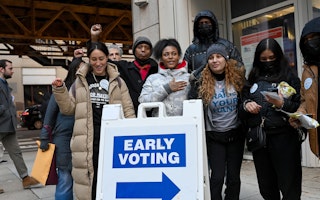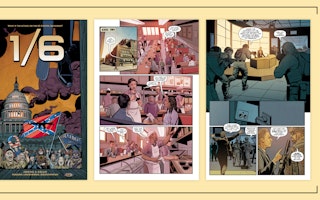In the inaugural forum of OSI's "Photography as Advocacy" series,Andrew Lichtenstein and Steve Liss discussed how they have useddocumentary photography to examine the social, political, and economicrepercussions of the U.S. criminal justice system. They were joined byAdam Rodriguez, a Laredo, Texas juvenile probation office who workedclosely with Liss on the photographer's recent project in that southernTexas city.
The forum was moderated by Susan Meiselas, a photographer who willserve in a similar capacity for future forums in the series. The seriesfocuses on photographers who have participated in OSI's Moving Wallsexhibit. Panelists analyze the role that photography plays in advocacy,the extent to which it is successful, and how those involved assubject, photographer, or audience perceive the work and its effect.Participants also consider how a photographer's agenda influences thefinished project.
Both Lichtenstein and Liss are included in the Moving Walls 8 exhibit.Lichtenstein's photos, "The True Cost of Prison," examine the massiveU.S. prison complex through the stories of those who know it firsthand.In "No Place for Children: Voices from Juvenile Detention," Lissfocuses on inmates in an underresourced, overcrowded juvenile detentioncenter near Laredo, seeking to challenge viewers to see theincarcerated youths not as a social ill but as a social responsibility.
Summary
Steve Liss said his Laredo project, "No Place for Children: Voices from Juvenile Detention," came about somewhat serendipitously a few years ago during a cross-country trip in search of a project related to children. While in Laredo, he was referred by a children's advocacy organization to Adam Rodriguez, a juvenile probation officer who brought him to the facility for the first time. "I was deeply moved by what I saw," Liss said, "...and I knew this is what I wanted to do." He subsequently spent several months visiting with incarcerated kids, staff, and parents, taking photos that tell a story of poverty, crime, neglect, and inspiration among troubled young people and those in their lives—a story, he says, that is replicated elsewhere throughout the United States, not just Laredo. His photos have been collected in a book that will be published later this year by the University of Texas Press.
While acknowledging the universality of Liss's photos, Rodriguez presented an overview of Laredo (which he called a "small city with big problems") that touched on many of the unique issues facing the city and its youth. Laredo is currently the country's fastest-growing city—its population has doubled over the past decade to 215,000—and is one of the largest and busiest border crossings between the United States and Mexico. It is a mostly Latino city with a relatively affluent north side dwarfed in sheer numbers by a less-affluent south side. The explosive population growth forces Laredo to add a new school every year. Even so, many of these schools are dangerous and overcrowded: authorities have identified 77 gangs, with at least 1,000 total members, in local school districts.
Several years ago, voters approved an $11 million bond issue to build a new juvenile facility to replace the current one, which has fewer than 50 beds. However, construction has been delayed due to a variety of factors. A strong advocate of the new facility, Rodriguez expressed frustration over the delay and noted that the city would have to pay a penalty exceeding $300,000 if construction did not begin by September 2004.
Rodriguez said that Liss's project—and advocacy-oriented photography in general—was vital in the midst of such ongoing frustrations. The photos and stories related to them can prompt the city to change policies to better serve its juveniles, he said. The "pictures speak very loudly," Rodriguez said, adding that he hoped that officials would respond positively "to the power of these photos" and renew efforts to build the new facility and allocate additional resources and attention to Laredo's young people and their problems.
Liss agreed, adding that he thinks it is important to show the photos in places such as Laredo itself, not just in traditional outlets like the International Center of Photography in New York. He said that placing these photos in the state capital of Austin in 2005, the next time the Texas legislature meets, would have a potentially greater impact on true policy change than their appearance in Time magazine, for instance. Liss said, "I think people will look at photos of kids in cages and say, 'We've got to do more.'"
In his remarks, Andrew Lichtenstein said one of the most important lessons he'd learned is that photography, even of searing, graphic images, rarely effects significant outrage or "changes the world" on its own. "I feel photography by itself is just a drop in the bucket," he said: "Everyone here in this room has a role" in ending abuses and improving social conditions. The most important thing photography can do, he said, is serve as a catalyst and prompt action by people from all professions and interests—educators, government officials, law-enforcement authorities, etc.
Lichtenstein added that his recent work regarding criminal justice issues had convinced him of the dire need to change a system that is "completely dehumanizing." It is impossible that those incarcerated in a massive, 2,250-inmate Texas prison are anything more than just a number, he said.
Read more
Online Hate Speech
New SEC Complaint Says Meta Misled Shareholders over Myanmar Hate

A whistleblower complaint to the SEC argues that the social media giant Meta misrepresented its role in fueling violence against Myanmar’s Rohingya—highlighting the need for more platform accountability for online hate.
Civic Engagement
Bolstering Women and Youth, Linchpins of Democracy

Philanthropy has historically underfunded women and youth. Open Society’s new $50 million investment in their engagement addresses that imbalance—and builds on recent surges in civic engagement crucial to the future of American democracy.
Art and Activism
Reimagining January 6th

The insurrection at the U.S. Capitol left him in a cold sweat. Creating a comic book seemed like one way to reach people not obsessively following the news and spark activism to help defend a multicultural democracy.